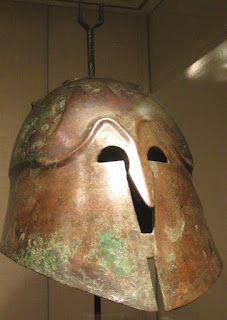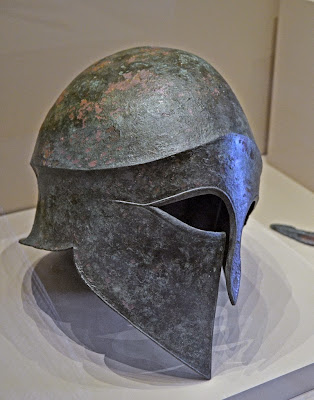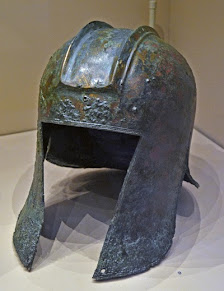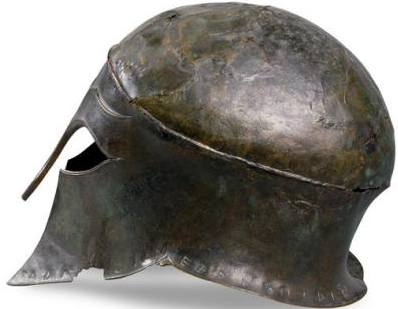 Flattened copper helmet and skull found in the Royal Tomb at Ur | At first, ancient helmets seem to have been pointed at the top, to deflect the downward force. When the ax became popular as a weapon, the shape of the helmet was modified to counter the cutting edge of a downward-falling blade. |  |
 Stele of Vultures circa 2500 BC. King Eannatum of Lagash leads a phalanx of soldiers with metal helmets, armed with spears and socketed axes. They are trampling over the bodies of their enemies. | The technology of armor was constantly evolving. By 3,000 BC metal workers were making helmets of copper. 500 years later the Sumerians had bronze helmets, spears and axes.  |   Egyptian soldier in the act of killing a warrior of the 'Sea Peoples' in the Medinet Habu temple relief |
 Corinthian helmet |  The Helmet of Agighiol is a Geto-Dacian silver helmet dating from the 5th century BC. |  Sutton Hoo helmet reconstructed |  The Golden Helmet of Coţofeneşti |
 | This 2,600-year-old bronze helmet was discovered in the waters of Haifa Bay, Israel in 2012. When it was made Greek colonies dotted the Mediterranean coast, stretching from the Black Sea to southern France. This warrior was likely one of Egyptian pharaoh Necho II's mercenaries, which he sent through Israel accompanied by a fleet of ancient ships. The pharaoh was involved in military campaigns in the region for nearly a decade, operations in which this warrior and his group likely were involved. |  |
 |  |  |
 |  Bronze Helmet from Ancient Greece, around 460 BC |  Roman horseman's helmet. |
 Gladiator helmet |  Greek Spartan Crest Helmet |  Spanish morion (helmet) |
 Helmet of the Chou Dynasty, Emperor Wu Wang tomb complex at Laoyang, circa 1020 BC.  Japanese helmet, circa 1590–1640. |  Helmet of a Yuan Dynasty officer  Chinese chichak-style helmet, Ming Dynasty |   Helmet from 7th century Viking boat grave |
 | A myth about Vikings was that they wore horned helmets. There is no proof that Viking helmets had horns. The reason their helmets didn't have horns was because they would have gotten in the way in battle and would injure the wearer. Real Viking helmets had protective metal down and around the ears and some helmets found in burial mounts had a metal mask in front. |  |
 German helmet by famous armorsmith Jörg Seusenhofer ca. 1540 |  |  |

No comments:
Post a Comment